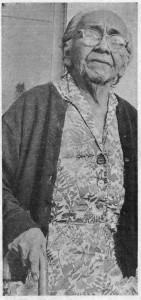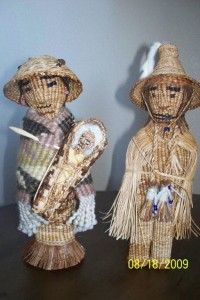lalacut
Agnes Jules James
lalacut – Agnes Jules James
1889-1971

Agnes James was the daughter of Charles Jules, the last of the hereditary Snohomish leaders to be appointed by the United States government to hold an official position as the representative of his community.1
Agnes made sure that the younger generations of her family knew the family they came from.1
Agnes used to sit on a low bluff overlooking Tulalip Bay, with her cooking utensils by her side, knitting and waiting for the fishermen to come in. They would give her fish and shellfish, and she would fix dinner for all. As people talk about Agnes, they evoke a person deeply involved in many walks of tribal life. She was one of four women who used to stand beside the priest at Mass, translating his words into Lushootseed for the congregation. Agnes’ spiritual commitment extended beyond the Catholic Church, in which she raised her four children. Marya Moses spoke often of the material and spiritual help that Agnes gave to the generation of young people who revitalized the longhouse way of life after it had lain dormant for years.
The late Stephanie Blackford, Agnes’ granddaughter, remembered her grandmother teaching her how to get a drink of water from a horsetail, how to make a cup from a skunk cabbage leaf, how to find the little plant underfoot that would heal a cut or cure a sore throat. From Agnes, Stephanie learned how to weave cedar. As she taught, Agnes told stories, some serving as lessons that applied to recent misbehaviour, and many more just so that Stephanie would have them to pass on. In the 1990s, when the Tribes established the Cultural Resources Department, Stephanie heard her grandmother’s voice telling her to “get in there and teach people how to make baskets before it gets forgotten.”

So Stephanie “got in there” and taught a generation of new weavers how to make baskets, mats, hats, and dolls. Among her pupils was Lance Taylor, Lizzie Krise’s great-grandson, now a master weaver. As she taught, Stephanie would tell her grandmother’s stories, just as she had been told them when she was a learner.
Agnes was famous for her dolls, which can be seen in the collections of the Smithsonian Institution and the Burke Museum. She began making them one Christmas when Stephanie asked for a baby doll, the kind you could buy at the store. Judy Gobin recalls that Agnes said, “You don’t want a doll like that. You want a doll like us.” She stayed up all night making a cedar doll for her granddaughter. As Stephanie grew older, Agnes would make just the head and shoulders of a doll and then have Stephanie finish it. Still later, Stephanie was entrusted with making the whole doll.
Towards the end of her life, it was a sorrow to Agnes that only two friends remained with whom she could speak Lushootseed: Marya Moses and Ethel Sam. It seemed to her that much of what she had held dear was being forgotten. We are consoled on her behalf to see her skills living on, an important part of the life of our Tribe.
1This introduction combines the memories of the late Stephanie Blackford Charlie, the late Marya Moses, Judy Gobin, the late Hank Gobin, and Lita Sheldon.
